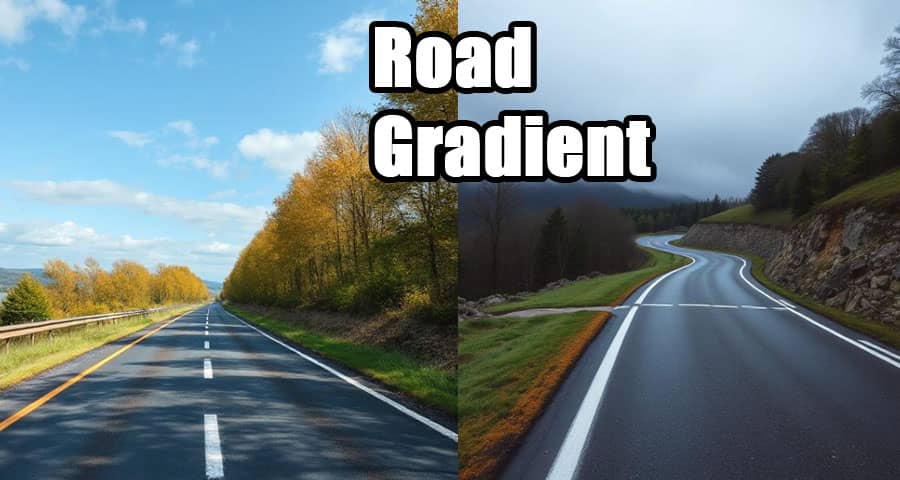Gradients on Roads: A Simple Guide to Types and Their Impact

Introduction to Road Gradient
In the field of transportation engineering, one of the critical aspects of road design is the gradient. The gradient of a road refers to the longitudinal slope along its alignment, expressed as a ratio or percentage, such as 1 in 20 or 5%. This slope plays a significant role in determining vehicular performance, fuel efficiency, drainage, and safety. Road gradients are implemented to overcome terrain challenges, ensuring economical and functional roadways.
Definition of Road Gradient
A road gradient is defined as the rate of rise or fall of the road surface with respect to the horizontal plane. It is typically expressed in one of the following forms:
- Percentage (%) - Example: 4% gradient means the road rises or falls by 4 meters over 100 meters of horizontal distance.
- Ratio (1 in n) - Example: 1 in 25 implies a 1-meter rise or fall for every 25 meters traveled horizontally.
Gradients are essential in areas of varying topography, especially in hilly and mountainous regions.
Importance of Gradients in Road Design
- Facilitates smooth traffic flow in uneven terrain
- Enhances drainage by allowing water runoff
- Ensures safety by avoiding excessive steepness
- Reduces construction costs by minimizing earthwork
- Improves vehicle performance in inclined and declined stretches
Types of Road Gradients
Gradients are broadly classified based on their function and terrain conditions. Each type has specific characteristics tailored to meet the operational and safety needs of a roadway.
1. Ruling Gradient
Ruling Gradient is the maximum gradient adopted in the design of the road under normal conditions. It provides a balance between ease of construction, cost-effectiveness, and vehicle operation. This is the standard gradient used where terrain allows, without compromising safety or performance.
- Plain Areas: 1 in 30 to 1 in 40
- Hilly Terrain: 1 in 15 to 1 in 20
- Urban Roads: 1 in 25
Effect: Ensures comfort and economy in vehicle operations.
2. Limiting Gradient
When ruling gradient cannot be maintained due to topographical constraints, the limiting gradient is adopted. This is the steepest permissible gradient for a particular class of road.
- Used in steep terrains where cutting and filling is costly or impractical.
- Short stretches only.
Effect: May slightly reduce comfort and fuel efficiency but helps avoid excessive construction work.
3. Exceptional Gradient
The exceptional gradient is steeper than the limiting gradient and is used only in extreme cases, such as crossing a steep hill or natural obstacle.
- Usage limited to very short stretches (less than 100 meters).
- Requires caution signs and additional safety measures.
Effect: Affects vehicular control and fuel consumption; often leads to lower design speeds.
4. Minimum Gradient
This is the least slope provided to enable proper drainage, especially on flat terrain.
- Common in urban roads and highways in plain areas.
- Minimum Gradient: Around 1 in 500 to 1 in 1000
Effect: Ensures water runoff, preventing pavement deterioration due to water logging.
5. Average Gradient
This is the overall gradient measured over entire road sections. It helps evaluate the general slope for maintenance planning and driving performance assessment.
Vertical Curves and Gradients
Where there is a change in gradient, vertical curves are introduced to ensure smooth vehicular transition. These curves reduce the suddenness of slope change, improving riding comfort and driver visibility.
- Summit Curves - for rising to falling gradient
- Valley Curves - for falling to rising gradient
Effect: Improves driver control and visibility distance, ensuring safety at high speeds.

Factors Affecting Gradient Selection
The design of road gradient depends on multiple critical parameters:
1. Topography
- Hilly or mountainous terrain may require steeper gradients
- Flat terrain enables more uniform and gentle gradients
2. Type of Road
- National Highways (NH) and Expressways: Require gentle gradients for high-speed travel
- Village or Rural Roads: Can accommodate steeper gradients
3. Vehicle Load and Type
- Heavily loaded vehicles struggle on steeper gradients
- Design must consider traction and braking characteristics
4. Climatic Conditions
- In snow-bound regions, steeper gradients can cause skidding
- Require minimum gradients for snow and rainwater drainage
Effects of Road Gradient
Gradients significantly influence the functionality, economy, and safety of the road. Below are the most notable effects:
1. Vehicle Performance
- Uphill gradients require more engine power, reducing fuel efficiency
- Downhill gradients increase braking effort, risking brake failure on long descents
2. Safety and Control
- Sharp gradients reduce reaction time and control during emergency braking
- Poorly designed gradients contribute to runaway vehicle incidents
3. Drainage
- Adequate slope ensures quick surface water runoff
- Prevents water stagnation, which leads to pavement damage
4. Construction and Maintenance Costs
- Steeper gradients often mean less earthwork, reducing initial construction cost
- But they may lead to higher maintenance costs due to erosion and wear
5. Comfort
- Sudden changes in gradient without proper vertical curves result in jerky rides
- Smooth gradients enhance driving comfort and reduce wear and tear on vehicles
Design Considerations for Safe Gradient Transitions
To ensure user safety and longevity of the road, designers must consider:
- Transition zones with vertical curves
- Warning signs for steep gradients
- Use of retaining walls in hilly areas
- Provision of escape lanes or braking ramps on long downhill stretches
Conclusion
An effective road design is incomplete without carefully planned gradients. From ensuring smooth travel to optimal drainage and vehicle safety, gradients are the backbone of functional road infrastructure. As engineers, we must balance the technical feasibility, cost-efficiency, and user safety while selecting and implementing road gradients.
Please watch the following short video for Gradients on Roads
